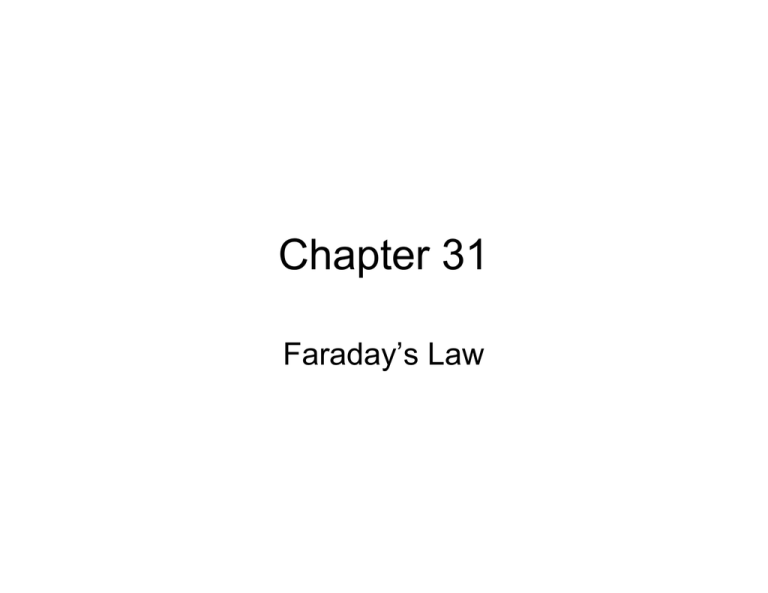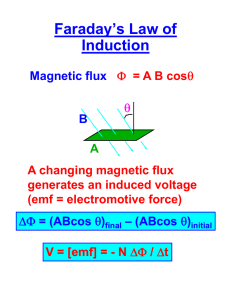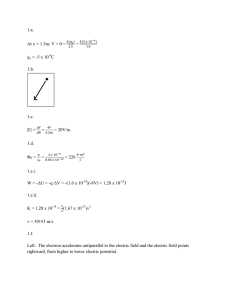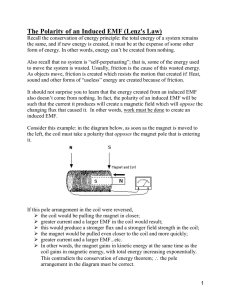Faraday`s Law
advertisement

Chapter 31 Faraday’s Law Michael Faraday • 1791 – 1867 • British physicist and chemist • Great experimental scientist • Contributions to early electricity include: – Invention of motor, generator, and transformer – Electromagnetic induction – Laws of electrolysis Induction • An induced current is produced by a changing magnetic field • There is an induced emf associated with the induced current • A current can be produced without a battery present in the circuit • Faraday’s law of induction describes the induced emf EMF Produced by a Changing Magnetic Field, 1 • A loop of wire is connected to a sensitive ammeter • When a magnet is moved toward the loop, the ammeter deflects – The direction was arbitrarily chosen to be negative PLAY ACTIVE FIGURE EMF Produced by a Changing Magnetic Field, 2 • When the magnet is held stationary, there is no deflection of the ammeter • Therefore, there is no induced current – Even though the magnet is in the loop PLAY ACTIVE FIGURE EMF Produced by a Changing Magnetic Field, 3 • The magnet is moved away from the loop • The ammeter deflects in the opposite direction • Use the active figure to move the wires and observe the deflection on the meter PLAY ACTIVE FIGURE Active Figure 31.1 PLAY ACTIVE FIGURE EMF Produced by a Changing Magnetic Field, Summary • The ammeter deflects when the magnet is moving toward or away from the loop • The ammeter also deflects when the loop is moved toward or away from the magnet • Therefore, the loop detects that the magnet is moving relative to it – We relate this detection to a change in the magnetic field – This is the induced current that is produced by an induced emf Faraday’s Experiment – Set Up • A primary coil is connected to a switch and a battery • The wire is wrapped around an iron ring • A secondary coil is also wrapped around the iron ring • There is no battery present in the secondary coil • The secondary coil is not directly connected to the primary coil PLAY ACTIVE FIGURE Active Figure 31.2 • Close the switch and observe the current readings given by the ammeter PLAY ACTIVE FIGURE Faraday’s Experiment – Findings • At the instant the switch is closed, the ammeter changes from zero in one direction and then returns to zero • When the switch is opened, the ammeter changes in the opposite direction and then returns to zero • The ammeter reads zero when there is a steady current or when there is no current in the primary circuit Faraday’s Experiment – Conclusions • An electric current can be induced in a loop by a changing magnetic field – This would be the current in the secondary circuit of this experimental set-up • The induced current exists only while the magnetic field through the loop is changing • This is generally expressed as: an induced emf is produced in the loop by the changing magnetic field – The actual existence of the magnetic flux is not sufficient to produce the induced emf, the flux must be changing Faraday’s Law – Statements • Faraday’s law of induction states that “the emf induced in a circuit is directly proportional to the time rate of change of the magnetic flux through the circuit” • Mathematically, dB ε dt Faraday’s Law – Statements, cont • Remember B is the magnetic flux through the circuit and is found by B B dA • If the circuit consists of N loops, all of the same area, and if B is the flux through one loop, an emf is induced in every loop and Faraday’s law becomes dB ε N dt Faraday’s Law – Example • Assume a loop enclosing an area A lies in a uniform magnetic field B • The magnetic flux through the loop is B = BA cos • The induced emf is = - d/dt (BA cos ) Ways of Inducing an emf • • • • The magnitude of B can change with time The area enclosed by the loop can change with time The angle between B and the normal to the loop can change with time Any combination of the above can occur Applications of Faraday’s Law – GFI • A GFI (ground fault indicator) protects users of electrical appliances against electric shock • When the currents in the wires are in opposite directions, the flux is zero • When the return current in wire 2 changes, the flux is no longer zero • The resulting induced emf can be used to trigger a circuit breaker Applications of Faraday’s Law – Pickup Coil • The pickup coil of an electric guitar uses Faraday’s law • The coil is placed near the vibrating string and causes a portion of the string to become magnetized • When the string vibrates at some frequency, the magnetized segment produces a changing flux through the coil • The induced emf is fed to an amplifier A flat coil of wire consisting of 20 turns, each with an area of 50 cm2, is positioned perpendicularly to a uniform magnetic field that increases its magnitude at a constant rate from 2.0 T to 6.0 T in 2.0 s. If the coil has a total resistance of 0.40 , what is the magnitude of the induced current? 1. 2. 3. 4. 5. 0.70 A 0.60 A 0.50 A 0.80 A 0.20 A A 400-turn circular coil (radius = 1.0 cm) is oriented with its plane perpendicular to a uniform magnetic field which has a magnitude that varies sinusoidally with a frequency of 90 Hz. If the maximum value of the induced emf in the coil is observed to be 4.2 V, what is the maximum value of the magnitude of the varying magnetic field? 1. 2. 3. 4. 5. 59 mT 62 mT 65 mT 68 mT 31 mT A square loop (length along one side = 20 cm) rotates in a constant magnetic field which has a magnitude of 2.0 T. At an instant when the angle between the field and the normal to the plane of the loop is equal to 20° and increasing at the rate of 10°/s, what is the magnitude of the induced emf in the loop? 1. 2. 3. 4. 5. 13 mV 0.27 V 4.8 mV 14 mV 2.2 mV






